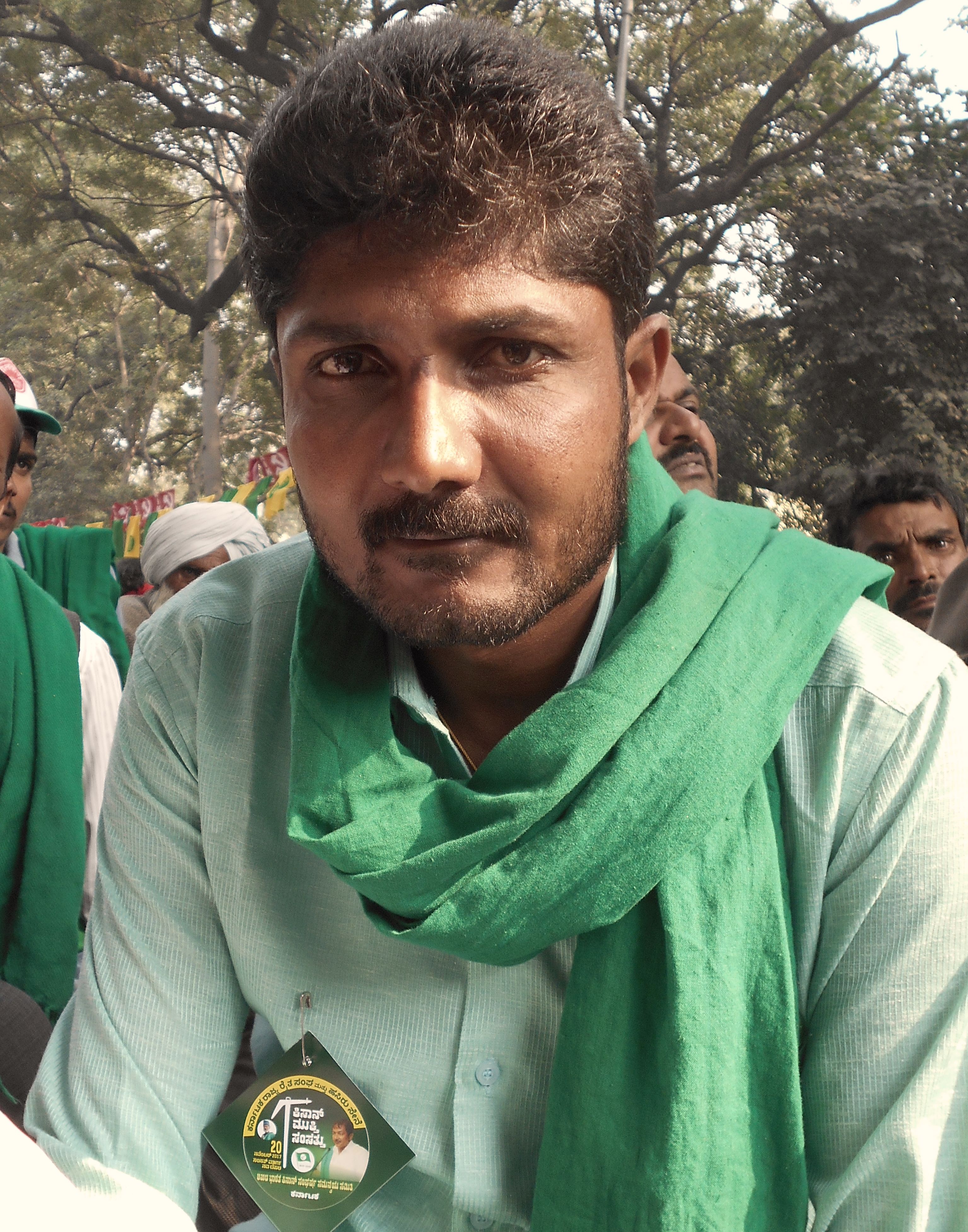Basavaraju, a deeply indebted peasant from Hassan, Karnataka. Of Basavaraju’s 7 acres land about half is tubewell irrigated on which they grow potato, ginger, tomato and chilly. When we interviewed Basavaraju in the Kisan Mukti Sansad, the household had a total outstanding debt of Rs 9.40 lakhs. Of this 6 lakhs were owed to a bank where the interest rate is about 7 per cent. About 3 lakhs had been borrowed from traders in Belur and Halebidu and from various informal lenders in the village. Most of these lenders charged an interest of 36 per cent per annum on the loan. In 2014, Basavaraju’s wife gave away her gold jewellery to obtain a gold loan from a bank in order to repay earlier high interest loans taken from local moneylenders. She has no gold left any more to pawn for a cheaper bank loan. Given the low levels of income this year again, the threat of having to sell a part of their land looms large on the family.

Basavaraju, about 36 years old, lives with his wife, two children and father in Hullenahalli village of Belur taluka in Hassan district, Karnataka. His mother passed away a few years ago. Basavaraju and his wife, the two main workers in the family, have studied up to high school. They own and work on 7 acres of land and maintain a cow. His father has studied only up to class 3. Basavaraju’s children, aged 12 and 10 years, go to the primary school in the village.
Hullenahalli is a relatively small village with about 125 households and a population of about 520 in 2011. Western talukas of Hassan district are agro-climatically suitable for production of plantation crops such as coffee and cardamom. Other agricultural and horticultural crops grown in irrigated land are paddy, sugarcane, coconut, potato and vegetables. Ragi, cotton, groundnut and other millets are grown in unirrigated lands.
Of Basavaraju’s 7 acres land about half is tubewell irrigated on which they grow potato, ginger, tomato and chilly. Of this, 2.5 acres has a drip irrigation system for which the household had to invest Rs. 75,000. The drip irrigation system has a life of about 6 years. The other half of their landholding is rainfed, on which cotton, tur dal, ragi and jowar are cultivated. Last year, cotton and tur dal were inter-cropped on 3 acres of rainfed land, while tomato and chillies were intercropped on half an acre of drip-irrigated land. A little over an acre of land was left fallow.
The household sold cotton, potato and ginger to traders who collected the produce from the field itself. Tomatoes were taken to the Agricultural Produce Market Committee (APMC) market in Chikmagalur (27 kms from their village) and chillies were sold in APMC market in Belur (20 kms from their village). Tur dal was sold to traders in Halebidu (12 kms from their village). Jowar was cultivated for green fodder and fed to cows owned by the household. Ragi was entirely self-consumed and not sold in the market.
Of all these crops, cotton was the only one from which Basavaraju earned some income. Although prices of cotton were lower this year than the last two years, Basavaraju was lucky to have escaped the wrath of pink bollworm, which destroyed much of the cotton crop in Maharashtra, Telangana and Karnataka this year. Consequently, over his paid out expenditure, he earned about 1.4 lakhs from 3 acres of cotton.
However, he incurred losses in all other crops put together. He had invested Rs. 64,410 in buying inputs and hiring workers for the half acre of tomato crop. Although he got 20 quintals of tomatoes, with a crash of tomato prices in the Chikmagalur mandi, he was forced to sell them only for Rs. 5 per kg. In case of potatoes also, which he had planted on one acre of land and had obtained 20 quintals, the fall in market price meant that he had to sell his potatoes for a loss of Rs. 14,500. The losses are much higher – Rs. 55,000 from all crops other than cotton – if we account for value of his own labour and resources.
Given low levels incomes for last several years, Basavaraju’s family has had to incur a lot of debt. When we interviewed Basavaraju in the Kisan Mukti Sansad, the household had a total outstanding debt of Rs 9.40 lakhs. Of this 6 lakhs were owed to a bank where the interest rate is about 7 per cent. About 3 lakhs had been borrowed from traders in Belur and Halebidu and from various informal lenders in the village. Most of these lenders charged an interest of 36 per cent per annum on the loan. In 2014, Basavaraju’s wife gave away her gold jewellery to obtain a gold loan from a bank in order to repay earlier high interest loans taken from local moneylenders. She has no gold left any more to pawn for a cheaper bank loan. Given the low levels of income this year again, the threat of having to sell a part of their land looms large on the family.
Jesim Pais is Director, Society for Social and Economic Research.
This was originally published on NewsClick.in.
